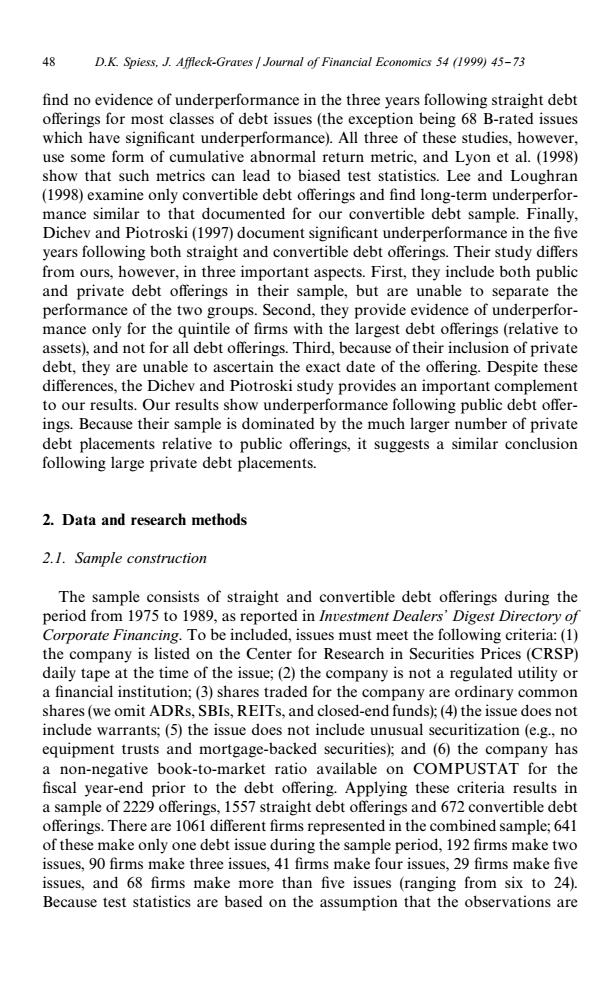正在加载图片...

48 D.K.Spiess,J.Affleck-Graves Journal of Financial Economics 54 (1999)45-73 find no evidence of underperformance in the three years following straight debt offerings for most classes of debt issues (the exception being 68 B-rated issues which have significant underperformance).All three of these studies,however, use some form of cumulative abnormal return metric,and Lyon et al.(1998) show that such metrics can lead to biased test statistics.Lee and Loughran (1998)examine only convertible debt offerings and find long-term underperfor- mance similar to that documented for our convertible debt sample.Finally, Dichev and Piotroski(1997)document significant underperformance in the five years following both straight and convertible debt offerings.Their study differs from ours,however,in three important aspects.First,they include both public and private debt offerings in their sample,but are unable to separate the performance of the two groups.Second,they provide evidence of underperfor- mance only for the quintile of firms with the largest debt offerings(relative to assets),and not for all debt offerings.Third,because of their inclusion of private debt,they are unable to ascertain the exact date of the offering.Despite these differences,the Dichev and Piotroski study provides an important complement to our results.Our results show underperformance following public debt offer- ings.Because their sample is dominated by the much larger number of private debt placements relative to public offerings,it suggests a similar conclusion following large private debt placements. 2.Data and research methods 2.1.Sample construction The sample consists of straight and convertible debt offerings during the period from 1975 to 1989,as reported in Investment Dealers'Digest Directory of Corporate Financing.To be included,issues must meet the following criteria:(1) the company is listed on the Center for Research in Securities Prices(CRSP) daily tape at the time of the issue;(2)the company is not a regulated utility or a financial institution;(3)shares traded for the company are ordinary common shares(we omit ADRs,SBIs,REITs,and closed-end funds);(4)the issue does not include warrants;(5)the issue does not include unusual securitization (e.g.,no equipment trusts and mortgage-backed securities);and (6)the company has a non-negative book-to-market ratio available on COMPUSTAT for the fiscal year-end prior to the debt offering.Applying these criteria results in a sample of 2229 offerings,1557 straight debt offerings and 672 convertible debt offerings.There are 1061 different firms represented in the combined sample;641 of these make only one debt issue during the sample period,192 firms make two issues,90 firms make three issues,41 firms make four issues,29 firms make five issues,and 68 firms make more than five issues (ranging from six to 24). Because test statistics are based on the assumption that the observations are"nd no evidence of underperformance in the three years following straight debt o!erings for most classes of debt issues (the exception being 68 B-rated issues which have signi"cant underperformance). All three of these studies, however, use some form of cumulative abnormal return metric, and Lyon et al. (1998) show that such metrics can lead to biased test statistics. Lee and Loughran (1998) examine only convertible debt o!erings and "nd long-term underperformance similar to that documented for our convertible debt sample. Finally, Dichev and Piotroski (1997) document signi"cant underperformance in the "ve years following both straight and convertible debt o!erings. Their study di!ers from ours, however, in three important aspects. First, they include both public and private debt o!erings in their sample, but are unable to separate the performance of the two groups. Second, they provide evidence of underperformance only for the quintile of "rms with the largest debt o!erings (relative to assets), and not for all debt o!erings. Third, because of their inclusion of private debt, they are unable to ascertain the exact date of the o!ering. Despite these di!erences, the Dichev and Piotroski study provides an important complement to our results. Our results show underperformance following public debt o!erings. Because their sample is dominated by the much larger number of private debt placements relative to public o!erings, it suggests a similar conclusion following large private debt placements. 2. Data and research methods 2.1. Sample construction The sample consists of straight and convertible debt o!erings during the period from 1975 to 1989, as reported in Investment Dealers+ Digest Directory of Corporate Financing. To be included, issues must meet the following criteria: (1) the company is listed on the Center for Research in Securities Prices (CRSP) daily tape at the time of the issue; (2) the company is not a regulated utility or a "nancial institution; (3) shares traded for the company are ordinary common shares (we omit ADRs, SBIs, REITs, and closed-end funds); (4) the issue does not include warrants; (5) the issue does not include unusual securitization (e.g., no equipment trusts and mortgage-backed securities); and (6) the company has a non-negative book-to-market ratio available on COMPUSTAT for the "scal year-end prior to the debt o!ering. Applying these criteria results in a sample of 2229 o!erings, 1557 straight debt o!erings and 672 convertible debt o!erings. There are 1061 di!erent "rms represented in the combined sample; 641 of these make only one debt issue during the sample period, 192 "rms make two issues, 90 "rms make three issues, 41 "rms make four issues, 29 "rms make "ve issues, and 68 "rms make more than "ve issues (ranging from six to 24). Because test statistics are based on the assumption that the observations are 48 D.K. Spiess, J. A{eck-Graves / Journal of Financial Economics 54 (1999) 45}73